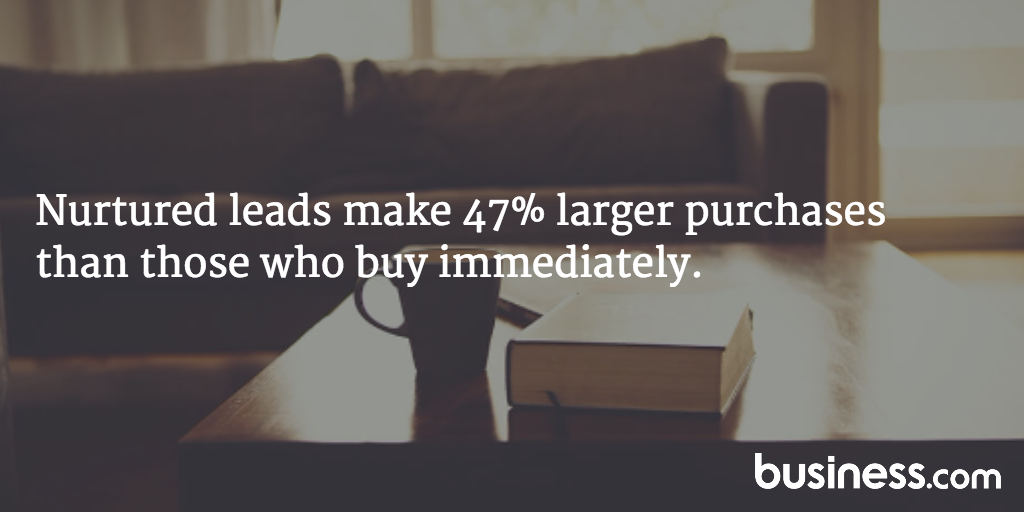You've got leads.
Prospective customers who want to buy.
They've made a beeline for your website and opted in. Some of them explicitly stated that they need your product.
Yet 75% of them aren't buying. What gives? Why aren't they buying?
They won't buy because they're not ready.
But it gets worse. According to Gleanster Research, 50% of the leads you generate are qualified, but not ready to buy right now. 25% of the leads you generate are totally unqualified; they won't ever buy. In fact at any given time, only 25% of your leads are ready to buy, and that's being optimistic.

Remember that 50% I mentioned?
Research studies state 80% of these people are going to buy from someone in the next 24 months. This is where lead nurturing comes into play. The Annuitas Group found that nurtured leads make 47% larger purchases than those who buy immediately. So you develop a relationship, following up with customers until they're ready to buy.
But you already knew that, right?
So why isn't that happening? A recent report from MarketingSherpa found that 79% of leads never turn into sales. Lack of lead nurturing was listed as the most common cause of poor performance.
So why aren't businesses doing this?
Most don't know what to do or where to start. What sort of communication moves customers closer to laying that golden egg? How do you get them to buy? Is a hard sell too much?
It's easy to believe there's a laundry list of things that need to be done before you can make the sale. But the reality is, there are only three things you need to do well to get customers to buy.
- Agitate their problems, solve them, then repeat.
- Make regular deposits in your customer's emotional bank account.
- Get a consistent, yet steady stream of micro yeses.
Related Article: Are You A Creep? How Far Is Too Far In Personalization Marketing & Sales Tactics?
1. Agitate their problems, solve them, then repeat.
Problems get our attention much more than the solution. In his classic study, John Cacioppo, Ph.D showed that people have intense and immediate reactions to things they perceive as negative.
Problems create fear and anxiety. Solutions relieve fear and anxiety.
Customers have different types of problems they need you to solve. You'll need triggers to get their attention. Then there's the problem they're expecting your product to solve. They need you to deal with their objections, risk reversals and social proof.
But they'll need your help even after they've bought your product. Why?
All products and services create new problems for you to solve. Buy a car or lawn mower and suddenly you have an expensive tool that needs oil and gas, maintenance, replacement parts and regular cleaning. These problems didn't exist until you decided to buy the car or lawnmower. It's the same with your business.

2. Make regular deposits in your customer's emotional bank account.
A marriage proposal on the first date scares most people off. Yet that's the same mistake most companies make when they expect customers to buy right away. Want them to commit? Make regular deposits in their emotional bank account.
How do you do that? Start by giving. This doesn't mean you flood them with content marketing spam. You give them the things they actually want, and you find out what they want by asking and observing.
Ask your customers about their problems, and watch the things they respond to. Did they respond well to those infographs you created? Customers raving about your latest blog post? Use the data you've accumulated to create more.
Do everything you can to give consistently to customers, before asking for a commitment. Create the tools, resources and content your customers need to give your team leverage. But whatever you do, don't abandon the relationship.
3. Get a consistent yet steady stream of micro yeses.
Remember the time where you signed up for a free offer and got an unexpected phone call the next day? Remember how persistent they were, how they wanted you to buy something you weren't quite ready for?
If you're like most people, that approach didn't work.
Mastering the micro yes is vital if you want to close more sales. A new customer relationship is fragile. There's only so much it can handle. These customers usually aren't ready to buy an expensive, premium product.
It takes time.
It's sort of like school. It's not really a great idea to stick a 1st grader with 8th grade work. Treat your prospects like that 1st grader. Give them "grade appropriate" material and time.
Then give them legitimate reasons to say yes repeatedly and you can move them to the big yes (whatever that is for you).
It sounds like a long process and it often is.
Related Article: Lessons from Business School: You Can’t Spell “Sales” without Four Ps
Selling 75% more takes time.
How do you get customers to buy faster? And without the buyer's remorse that usually follows a rushed sale? You increase their want. Increasing their desire doesn't necessarily mean "increasing their desire for your product."
It could mean they really want their problem to go away. Or that they really want the benefits associated with your product. There's a certain level of prestige that usually comes with luxury products.
It's not unusual for customers to use a particular product or service to deal with insecurities or perceived shortcomings. These customers don't necessarily want your product per se; they want the things that come with your product.
There's a fine line between increasing want and manipulation. It's important to stay on the right side of that.
Customers buy what they want, when they want.
It's true. But there are lots of factors that influence those wants. Anything and everything from desires to social expectations and insecurity can influence those wants.
Working with your customer's wants means agitating what's already there, shortening the sales cycle. Manipulating customer wants means acting dishonestly, introducing something that's not there (or twisting something that is). As soon as customers believe you've manipulated them, they're angry and they want out.
Most of your customers want to buy.
Just not right now. The vast majority of them need time and three specific ingredients. Use them well and you'll see a dramatic increase in sales and revenue.
Want to generate an unlimited supply of warm, highly qualified leads? Download "How to Generate an Unlimited Supply of Leads for Free."